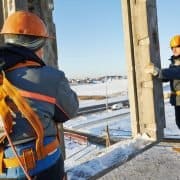Heat stress
Heat stress can be a killer on the job site. Outside of the direct consequences such as heat stroke, heat stress can cause incidents due to loss of focus or excessive fatigue on the job.
Heat-related illnesses
Heat cramps
Heat cramps are painful, brief muscle cramps. Muscles may spasm or spasm involuntarily. Heat cramps can occur during exercise or work in a hot environment or begin a few hours later.
Heat exhaustion
There are two types of heat exhaustion.
- Water depletion: Signs include excessive thirst, weakness, headache, and loss of consciousness.
- Salt depletion: Signs include nausea and vomiting, muscle cramps, and dizziness.
Heat stroke
Heat stroke is the most serious heat-related illness. Heat stroke can kill or cause damage to the brain and other internal organs. Heat stroke results from prolonged exposure to high temperatures — usually in combination with dehydration — which leads to failure of the body’s temperature control system.
Medical response
If anyone is displaying symptoms of a heat-related illness, it is important to get them the proper medical attention they need before the problem turns into heat stroke. The affected person needs to consume water or electrolyte replacing sports drinks.
Anyone who is displaying symptoms of a heat stroke, immediate medical attention is needed. Delaying calling 911 could result in irreversible injuries or death. Symptoms of heat stroke include fainting, throbbing headache, dizziness, lack of sweating, vomiting, or behavioral changes such as confusion.
Summary
Take heat stress seriously. Know the signs and symptoms of heat stress. Dealing with heat stroke especially, it may mean the difference between life and death.




 Thompsons Limited/Shutterstock
Thompsons Limited/Shutterstock 



